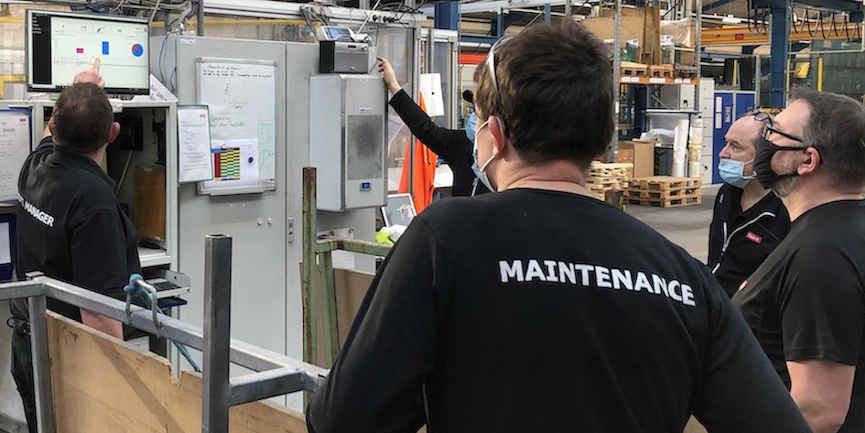
Marc Onetto on his experience with Jidoka at GE and Amazon
INTERVIEW – Catherine Chabiron sits down with Marc Onetto, a former executive with GE and Amazon, to discuss Jidoka and its profound effects on the way people work and think.
Interviewee: Marc Onetto, former SVP of Operations and Customer Service at Amazon and former VP of European Operations at GE Europe.
Interviewer: Catherine Chabiron, lean coach and Board member of Institut Lean France
Catherine Chabiron: As a Senior Executive at General Electric Medical Systems first and at Amazon.com later, can you tell us how lean have supported the growth and success of these two organizations?
Marc Onetto: Both Jack Welch, former CEO of General Electric, and Jeff Bezos, Founder and CEO of Amazon, knew exactly what they wanted and how to communicate it effectively to their organizations. As leaders, they both have the ability to dive deep into details. They are clever, and very demanding. But Jeff Bezos went one step further: focus the entire organization on customer satisfaction, knowing that customer centricity is the best fuel for growth. He would rather lose a sale than disappoint a customer, and is known to say that “Amazon doesn’t sell goods, but helps customers find what they need”.
Lean was clearly the best approach to deliver the challenging expectations that Jack and Jeff has set for the businesses. The first time I met Jeff Bezos, we had an exchange on his vision (“the most customer centric company in the world”) and I told him about lean and how it would help drive his vision into Operations through waste elimination and increased value for the customer. Jeff was very eager to go for it. In my seven years in Amazon, as Senior VP Operations and Customer Service, turnover grew tenfold from $7 billion to $70 billion, the number of distribution centers went from 20 to 120, customer service centers went from 5 to 25, and the number of employees from 12,000 to 120,000. It was a great and challenging experience.
CC: One of your major areas of focus was the use of Jidoka. When did you first come across the concept?
MO: At GE, I was one of the early adopters of 6 Sigma. The methodology was great to fix quality issues in process-intensive high-technology components like X-Ray tubes, but it didn’t work as well when dealing with the assembly and supply of complex machines. At one point, one of my Black Belts suggested we go for lean, so I read Lean Thinking by Womack and Jones. I got so curious that I decided to go to Japan with the team, to train with an ex Toyota sensei, Nakao-San of Shingijutsu.

Our week-long training started at the Toyota Automobile Museum in Nagoya. Nakao-San’s reception was cold, to say the least. We walked straight to the automated loom invented by Sakichi Toyoda, and spent 15 minutes there. At first, we failed to see the point: from time to time, a thread would snap, the loom stopped and everybody bowed in awe. I asked why couldn’t we go and see some car assembly, and Nakao-San icily retorted to “shut up, refrain from asking stupid questions and take notes”. I gritted my teeth and held on. Further observation made us realize the breakthrough those automated loom stops had brought on the quality of the silk fabrics. Nakao-San then declared we were ready to move over to the car assembly, as we had understood the underlying principle of Jidoka.
CC: Can you tell us about the implementation of lean and the use of Jidoka at GE?
MO: We had learned plenty during our week in Japan, particularly how to look at a production line and spot the waste. When we came back, my team immediately tried to figure out how much waste we had on a selected line and came back with an outrageous 92%. I said, “Nonsense. Go and check it again, please.” They came back later, telling me: “You were right. We made a mistake – it is actually 92.8%.”
I went through three stages of reaction. First came the shame, when I realized I was in charge of such a bad operation. Then came the fear, which would have led me to blame my predecessor had he not been a good friend of mine, and had I not been leading operations at GE Medical Systems for two years already. Surely, I thought, upon hearing of my incompetence, Jack Welch would fire me.
But then, the next morning, I started to look at the whole situation more positively: Jack Welch wanted a 10% increase in productivity per year and I had found myself a way to deliver it. So, we started digging and quickly got ready to implement Jidoka on the line.
After we got the line under control and sorted out the warehouse, we installed an andon cord and got started on a Monday morning with a new rule: every operator would have to pull the cord and stop the line if he or she found a defect. I set up a lamp in my office that would light up whenever the andon was pulled.
Nothing happened on the Monday, but the lamp went red on Tuesday morning. I went down to the line, which was stopped, and started to ask around. No one seemed to know who had pulled the cord. It turned out after a quick investigation that it had been a warehouse operator. Up to him we went and he explained that his standard was to have two bins full of parts and he only had one left instead. We called a material planner, who claimed the IT system was saying there were 500 parts available. When we pointed at the single bin that was left, he said the actual planner in charge had to be called. We did, and we learned that he had forgotten to explain the situation to his colleague and ask him to order parts. “Surely, we said, the MRP should have issued the order for the new parts automatically, why did you need to manually order?” “Well, the MRP cannot be relied upon because the Bill of Materials is no longer up-to-date since that change to the product five years ago.”
The production line was still stopped, when we got hold of the engineer who could update the BOM in the ERP system. He was very busy and tried to get out of the discussion, so we escalated to his boss. I was sticking to what I had learned from my sensei: “I won’t restart the line, unless you commit to solving that BOM issue.” Two hours later, the issue was fixed. It had taken 15 minutes to fix the MRP.
This is just an example of what you find again and again when you start applying Jidoka, an extremely powerful tool to detect issues that were swept under the carpet. Think about this: a 15-minute action had been postponed for five years and resulted in a huge risk of missed deliveries.
CC: Do you have a similar experience of andon and Jidoka at Amazon? Many people wrongly assume that Jidoka doesn’t apply outside of manufacturing…
MO: The principle of Jidoka applies everywhere, especially if we come down to its fundamental intent: preventing bad quality from going down the line and impacting the customer, understanding the causes of a problem as it happens, and giving the employee the authority (and autonomy) to stop the line when an issue occurs.
We applied the same idea at Amazon: if a customer complains about a product defect and the computer shows the service agent that the same defect has already been reported by another customer, the agent has the power to suspend sales of the item without asking management. Amazon’s quality lab will then carry out an inspection.
This took quite some time to achieve, as we had to ascertain that incidents were properly recorded and that the process to find and tackle the root cause was in place so that the item could be put back on sale quickly. Critically, Jeff Bezos was very keen to see this process put in place, not showing any worry about how this would impact sales.
The first Andon cord we encountered was when a customer complained that he received a hard disk when he had ordered headphones. The process works as follows: 1) the agent refunds the customer, 2) offers a replacement product of his choice, and 3) withholds the product from sale on the website. The agent will thank the customer for finding the issue and the site will now display a note saying the product is no longer for sale and with the Quality Lab for inspection.
Customers are often surprised to see that the operator can act so swiftly, not only on the problem but also on preventing it from reoccurring. What they don’t see is the cause analysis launched afterwards: in this case, the quality inspector sent to investigate the issue found that the provider of both headphones and hard disk had switched the barcode labels on the two products. The boxes were similar, the barcode flashed “ok” at picking, it went undetected until delivered to the customer. It took a week to check with the vendor, confirm the problem and change all the labels on the boxes.
CC: What effect does this have on morale?
MO: Operators in Customer Service Centers have a tough job. They receive complaints and have to listen to angry customers all day long. In most companies, they can only listen and record, and have no authority to solve the problem. This further delays the solution, as the agent has to find someone in charge who is available to help.
With Jidoka, we go the opposite direction, which has a huge impact on employee morale. At Amazon, we knew we could not anticipate or prevent all possible scenarios, so we wanted our operators to use their best judgement. To that effect, our job was to provide them with the right information on the potential recurrence of the incident. With this approach, we were eliminating between 50,000 to 100,000 defects per year during my time with the company. We were right to trust the agents: less than 2.5% of the andon pulls were found to be unnecessary, and most of those were based on a wrong information or on a customer mistake.
There was another advantage: with our system immediately spotting recurrences, we knew customers to be in complete good faith and could treat them as friends (instead of trying to determine whether the mistake had been theirs, for example in handling a box the wrong way and breaking the product inside). Solving a problem is all that really matters.

CC: Any recommendations for our readers?
MO: Lean can only work in customer-centric companies. Pulled flows and Jidoka make no sense if you are mostly focused on your internal processes (whether we are looking at unit cost reduction or optimizing the use of your heavy investments). Just to give you an idea: as a Senior VP at Amazon, I was personally looking at all the andon cords that had pulled and were not solved after two weeks. Customer focus will force you to go and see, solve problems, and learn. That’s what innovation stems from.
THE INTERVIEWEE

THE INTERVIEWER

Read more


CASE STUDY – The authors discuss how rooftop window producer VELUX harnessed Lean Thinking and Industry 4.0 to empower shop floor workers, after rediscovering the kaizen spirit following a digitalization initiative that didn’t work out.


FEATURE – BRQ Digital Solutions shows that effective customer-focused improvement must happen from the inside out, with team development aligned with the pillars of lean digital transformation.


WOMACK’S YOKOTEN – The rise of the robots may still belong in sci-fi books, but there is no doubt that work as we know it is fading away. What is the role of lean thinking in this world of drones and driverless taxis?


CASE STUDY - How does lean contribute to making Melbourne one of the world’s most liveable cities year after year? Denise Bennett explains the approach followed.

